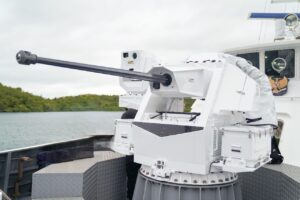The 30mm SMASH Naval Gun System has become one of the most trusted weapon stations for modern surface combatants due to its combination of high precision, remote operation, and flexible mission capability. Unlike legacy manually-operated mounts, this stabilized system allows the crew to control the turret safely from inside the ship, improving both survivability and response time.
Equipped with a 30×173 mm automatic cannon, the system provides highly accurate firepower against a range of threats commonly encountered during maritime operations. Thanks to its two-axis stabilization and automatic target tracking, it is capable of maintaining a steady aim point even while the vessel is maneuvering or operating in heavy sea conditions.

Multi-Threat Engagement Capability
One of the major strengths of the SMASH system lies in its ability to operate effectively across different scenarios:
- Anti-Surface.
Able to rapidly detect and neutralize small fast-moving surface craft such as speedboats and RHIBs.
- Asymmetric Warfare.
Ideal for maritime security missions and anti-piracy patrols, where precise graduated response is often required.
- Anti-Air.
Capable of engaging low-flying drones and helicopters during close-range encounters.
- Day/Night Surveillance.
Integrated electro-optic sensors (day camera, IR camera, and laser range finder) allow it to act as a powerful observation tool.
Ease of Installation and Integration
With a compact footprint and lightweight structure (around 1.9 tons), the system can be installed on patrol boats, OPVs, corvettes, or large naval vessels with minimal modification. It is designed to integrate with existing combat management systems through standard interfaces and can store up to 200 ready-to-use rounds internally, reducing reload frequency during operations.
Operational Value
The 30mm SMASH system enhances a ship’s deterrence posture by enabling rapid and precise engagement of emerging threats. Its stabilized platform ensures accurate bursts even in harsh sea conditions, while remote operation keeps the operator protected. For navies that frequently operate in congested littoral zones or conduct maritime security operations, the ability to quickly transition from surveillance to engagement provides a significant tactical advantage.
It also supports layered defense architectures by serving as the intermediate link between long-range missile systems and short-range small arms, making it an essential component of modern ship self-defense suites.

